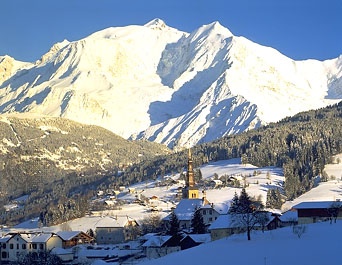Blanc, Mont
mountain, Europe
Italian Monte Bianco

 mountain massif and highest peak (15,771 feet 【4,807 m】) in Europe. Located in the Alps, the massif lies along the French-Italian border and reaches into Switzerland. It extends southwestward from Martigny, Switz., for about 25 miles (40 km) and has a maximum width of 10 miles (16 km). The summit is in French territory. Surrounding the massif are the Graian Alps (south), the Chamonix Valley and Savoy Alps (west), the Pennine Alps (northeast), and the Valley of Courmayeur (east). Other principal peaks within the massif include Mont Blanc du Tacul, Mont Maudit, Aiguille (“Peak”) du Géant, Les Grandes Jorasses, Mont Dolent, and Aiguille du Midi.
mountain massif and highest peak (15,771 feet 【4,807 m】) in Europe. Located in the Alps, the massif lies along the French-Italian border and reaches into Switzerland. It extends southwestward from Martigny, Switz., for about 25 miles (40 km) and has a maximum width of 10 miles (16 km). The summit is in French territory. Surrounding the massif are the Graian Alps (south), the Chamonix Valley and Savoy Alps (west), the Pennine Alps (northeast), and the Valley of Courmayeur (east). Other principal peaks within the massif include Mont Blanc du Tacul, Mont Maudit, Aiguille (“Peak”) du Géant, Les Grandes Jorasses, Mont Dolent, and Aiguille du Midi.Glaciers cover approximately 40 square miles (100 square km) of Mont Blanc (whence its name, meaning “white mountain”). Ice streams stretch from the central ice dome down to below 4,900 feet (1,490 m). The Mer de Glace, the second longest glacier in the Alps, reached the elevation of 4,100 feet (1,250 m) in 1930. At the beginning of the 17th century, glaciers advanced to the bottom of the Chamonix Valley, destroying or burying cultivated land and dwellings. Since that time, the glaciers have periodically advanced and retreated.
Scientists P. Martel in 1742, Jean A. Deluc in 1770, and, later, Horace Bénédict de Saussure (Saussure, Horace Bénédict de) first drew attention to Mont Blanc's distinction as western Europe's highest mountain. That designation stirred adventurers to climb the peak. The summit was conquered in 1786 by Michel-Gabriel Paccard, a doctor from Chamonix, together with Jacques Balmat, his porter. Paccard's achievement, one of the most important in the history of mountaineering, was overshadowed by de Saussure's ascent the year after. Through Marc-Théodore Bourrit, who failed the ascent and, out of jealousy, published a biased account of the first ascent, the myth was started that all credit for the climb was due to the peasant Balmat.
 In addition to mountaineers, the number of visitors to Chamonix increased steadily; but until about 1870, when an improved road was opened, it remained an exclusive resort. The region has come to form the largest Alpine tourist centre, with aerial tramways and facilities for winter sports, and its traditional pastoral economy has been completely eclipsed.
In addition to mountaineers, the number of visitors to Chamonix increased steadily; but until about 1870, when an improved road was opened, it remained an exclusive resort. The region has come to form the largest Alpine tourist centre, with aerial tramways and facilities for winter sports, and its traditional pastoral economy has been completely eclipsed.Additional Reading
Stefano Ardito, Mont Blanc: Discovery and Conquest of the Giant of the Alps, new extended and updated ed. (2006).
- Robert the Strong
- Robert Todd Lincoln
- Robert Torrens
- Robert Treat Paine
- Robert Trimble
- Robert Venturi
- Robert Walpole, 1st earl of Orford
- Robert Whitehead
- Robert Wilhelm Bunsen
- Robert William Fogel
- Robert William Holley
- Robert Williams Wood
- Robert Winchelsey
- Robert Wise
- Robert Wood Johnson
- Robert Woodrow Wilson
- Robert W. Service
- Robert Young Hayne
- Roberval balance
- Roberval, Gilles Personne de
- Roberval, Jean-François de La Rocque, Sieur de
- Robeson Channel
- Robeson, Paul
- Robespierre, Maximilien de
- Robey, Sir George